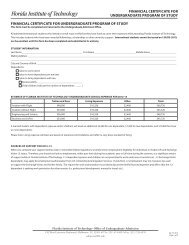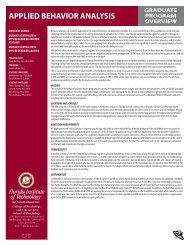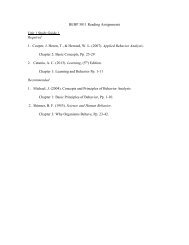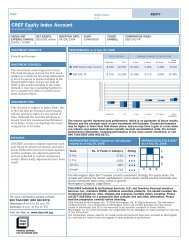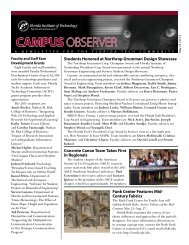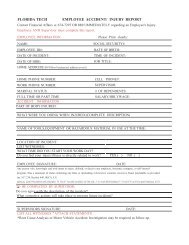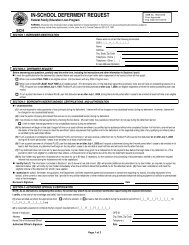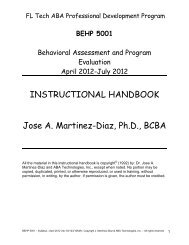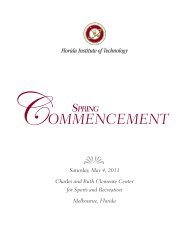2012–2013 UNIVERSITY CATALOG - Florida Institute of Technology
2012–2013 UNIVERSITY CATALOG - Florida Institute of Technology
2012–2013 UNIVERSITY CATALOG - Florida Institute of Technology
Create successful ePaper yourself
Turn your PDF publications into a flip-book with our unique Google optimized e-Paper software.
testing. License agreements in place with a number <strong>of</strong> industry<br />
leaders enable the implementation <strong>of</strong> research results in commercial<br />
quality hardware and s<strong>of</strong>tware products, focusing on assuring<br />
the integrity <strong>of</strong> computer hardware and s<strong>of</strong>tware applications from<br />
malicious intrusion. The institute performs funded hardware and<br />
s<strong>of</strong>tware testing, vulnerability testing, security assessments and<br />
basic research in computer security and s<strong>of</strong>tware development testing<br />
(see “Research” in the Institution Overview section).<br />
S<strong>of</strong>tware Evolution Laboratory (SEL): The primary mission <strong>of</strong><br />
this laboratory is to advance the state-<strong>of</strong>-the-art in evolving complex<br />
s<strong>of</strong>tware systems in a disciplined manner. This includes research<br />
related to legacy system re-engineering, reverse engineering,<br />
program understanding and s<strong>of</strong>tware maintenance. The systems<br />
in question can be traditional s<strong>of</strong>tware applications or Web-based<br />
applications. The secondary mission <strong>of</strong> the SEL is to advance the<br />
state-<strong>of</strong>-the-practice in s<strong>of</strong>tware evolution by transitioning results<br />
from the laboratory into widespread use through evidence-based<br />
arguments (such as empirical studies) that objectively support the<br />
efficacy <strong>of</strong> the techniques in question. Issues related to technology<br />
adoption are necessarily a part <strong>of</strong> this effort. An example <strong>of</strong> recent<br />
work is the investigation <strong>of</strong> the impact <strong>of</strong> test-driven development<br />
(TDD) techniques, such as Extreme Programming (XP), on longterm<br />
s<strong>of</strong>tware maintenance costs.<br />
DeParTmeNT oF eLeCTriCaL aND ComPUTer<br />
eNgiNeeriNg<br />
Samuel P. Kozaitis, Ph.D., Head<br />
Degree Programs<br />
Computer Engineering, B.S.<br />
Computer Engineering, M.S.<br />
Area <strong>of</strong> Specialization:<br />
Biomedical Engineering<br />
Computer Engineering, Ph.D.<br />
Electrical Engineering, B.S.<br />
Electrical Engineering, M.S.<br />
Areas <strong>of</strong> Specialization:<br />
Biomedical Engineering<br />
Electromagnetics<br />
Photonics<br />
Systems and Information Processing<br />
Wireless Systems and <strong>Technology</strong><br />
Electrical Engineering, Ph.D.<br />
Pr<strong>of</strong>essors<br />
Barry G. Grossman, Ph.D., fiber-optic sensor systems and smart structures,<br />
fiber-optic communications.<br />
John Hadjilogiou, Ph.D., P.E., switching theory, computer organization.<br />
Fredric M. Ham, Ph.D., Harris Pr<strong>of</strong>essor, digital signal processing, neural<br />
networks.<br />
Samuel P. Kozaitis, Ph.D., automated feature extraction, image processing.<br />
Syed H. Murshid, Ph.D., photonics, fiber-optic sensors, acoustic and<br />
fiber-optic communications, power electronics, instrumentation.<br />
Robert L. Sullivan, Ph.D., University Pr<strong>of</strong>essor, power systems, power<br />
electronics.<br />
Lynn E. Weaver, Ph.D., nuclear energy, control systems.<br />
Associate Pr<strong>of</strong>essors<br />
Georgios C. Anagnostopoulos, Ph.D., machine learning, pattern recognition.<br />
Susan K. Earles, Ph.D., semiconductor modeling, processing and fabrication,<br />
microelectronics, solid-state device physics.<br />
116 <strong>Florida</strong> Tech<br />
Veton Z. Këpuska, Ph.D., human-machine interaction and communication,<br />
speech recognition.<br />
Ivica Kostanic, Ph.D., telecommunications, wireless telecommunications.<br />
Brian A. Lail, Ph.D., antenna-coupled sensors, computational and applied<br />
electromagnetics, EMI, EMC.<br />
Assistant Pr<strong>of</strong>essor<br />
Stéphane Bucaille, Ph.D., free space optical communications, humanmachine<br />
interfaces.<br />
Adjunct Faculty<br />
T.L. Crandell, Ph.D.; T. Young, Ph.D.<br />
Pr<strong>of</strong>essors Emeriti<br />
Charles D. Beach, Ph.D.; Rufus H. C<strong>of</strong>er, Ph.D.;<br />
Raghvendra Deshmukh, Ph.D., P.E.; Andrew W. Revay Jr., Ph.D.;<br />
Thomas J. Sanders, Ph.D.; M. Mehdi Shahsavari, Ph.D.; H.P. Weber, D.Sc.<br />
Student Coordinator<br />
Cheryl Mitravich<br />
mission statement<br />
The mission <strong>of</strong> the Department <strong>of</strong> Electrical and Computer<br />
Engineering is to prepare students to become successful pr<strong>of</strong>essionals<br />
in a dynamic global environment. By fostering a desire<br />
for lifelong learning through a broad-based interdisciplinary core<br />
education, both electrical and computer engineering programs<br />
provide opportunities for undergraduate research that reflects the<br />
expanding world around us, and gives students the tools to advance<br />
the state-<strong>of</strong>-the-art in a chosen specialization area.<br />
UNDERGRADUATE DEGREE PROGRAMS<br />
Computer Engineering, B.S. ___________________<br />
major Code: 7042 Degree awarded: Bachelor <strong>of</strong> Science<br />
age restriction: N admission status: undergraduate<br />
Delivery mode/s: classroom only Location/s: main campus<br />
The goal <strong>of</strong> the computer engineering program is to provide the<br />
student with a total learning experience. The program is designed<br />
to expose the entire spectrum <strong>of</strong> computer engineering concepts<br />
from the basic building blocks <strong>of</strong> transistors and gates, through the<br />
progression <strong>of</strong> embedded controllers, computer architectures and<br />
high-performance digital signal processors. Students develop an<br />
extensive knowledge <strong>of</strong> hardware, along with a strong education in<br />
programming techniques to provide them with a complete understanding<br />
<strong>of</strong> computer systems. In the senior year, they design, build<br />
and test computer systems as part <strong>of</strong> their senior design course.<br />
The educational objectives for computer engineering are to produce<br />
graduates who will establish themselves as practicing pr<strong>of</strong>essionals<br />
who will engage in advanced studies in engineering or a related<br />
field; display awareness <strong>of</strong> the importance <strong>of</strong> an opportunities for<br />
lifelong learning; excel in the global marketplace; and demonstrate<br />
the ability to work successfully as members <strong>of</strong> pr<strong>of</strong>essional teams<br />
and function effectively as responsible pr<strong>of</strong>essionals.<br />
A major component <strong>of</strong> the computer engineering program at<br />
<strong>Florida</strong> Tech involves hands-on learning. The computer engineering<br />
student begins taking computer engineering courses during<br />
the Freshman year. The freshman-level courses include programming<br />
and interfacing an embedded microcontroller. Laboratory<br />
experience is integrated into most <strong>of</strong> our classes. In the junior year<br />
students are introduced to interfacing with a high-performance<br />
digital signal processor.<br />
In computer engineering, a strong focus is on the mastery principle.<br />
It is assured that computer engineering students not only know the




